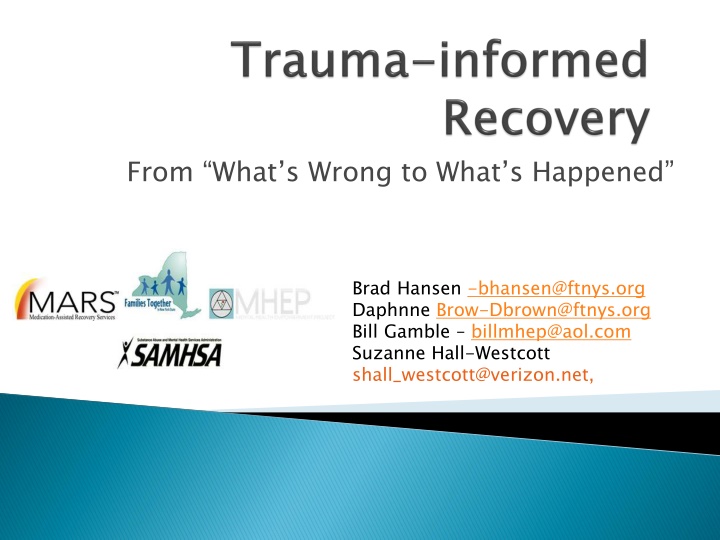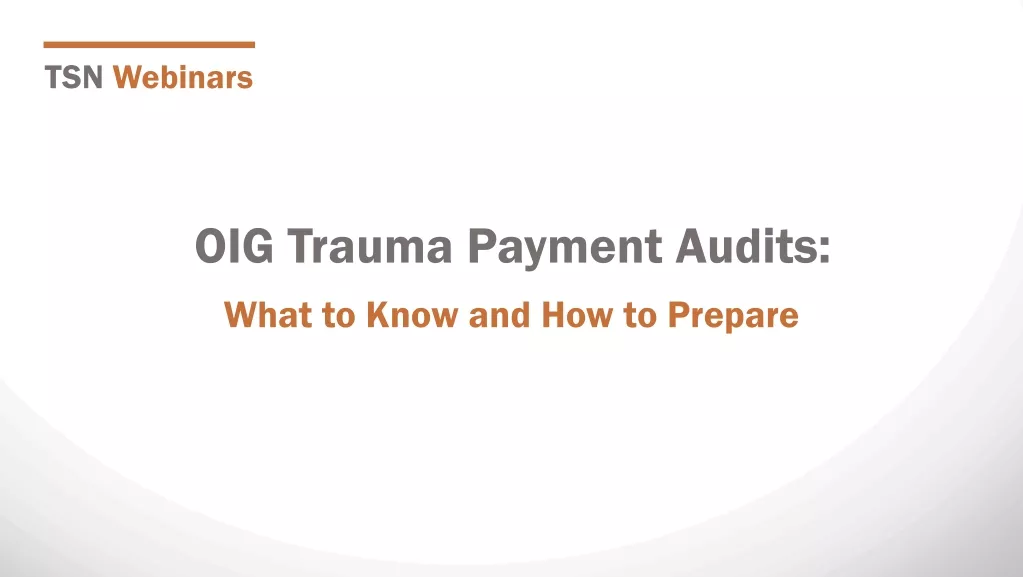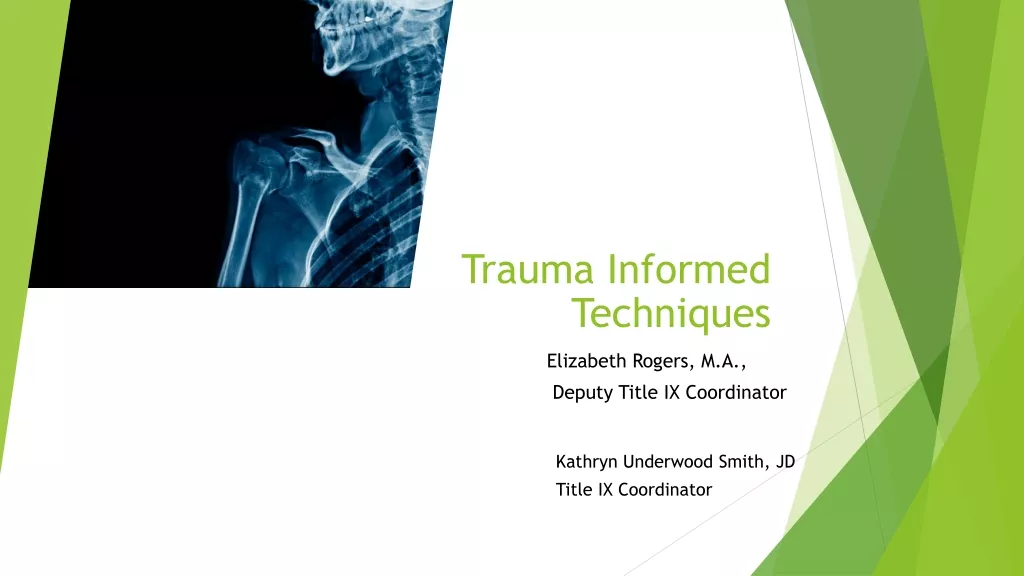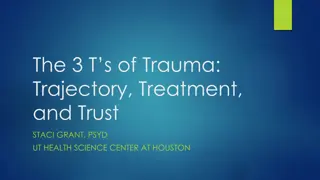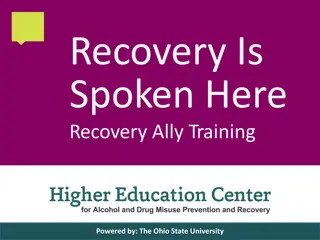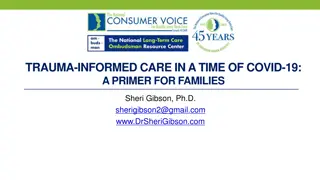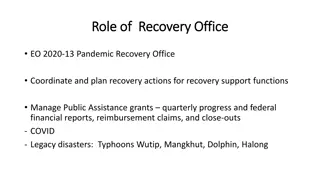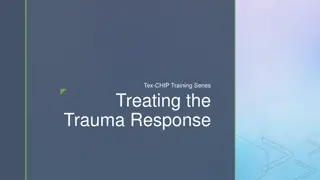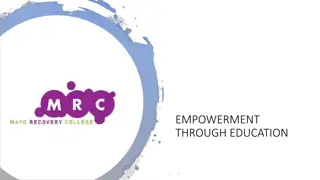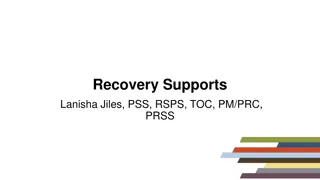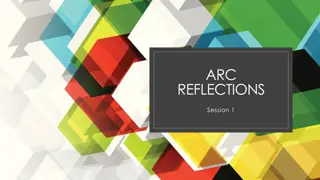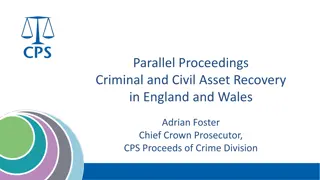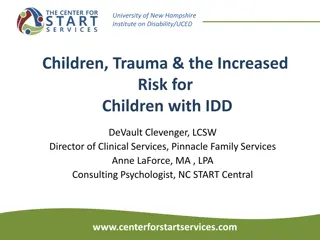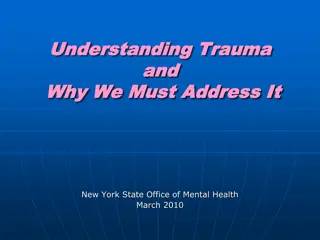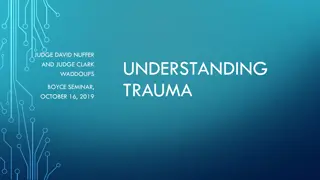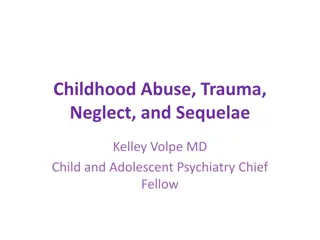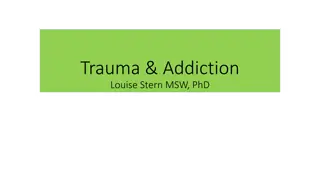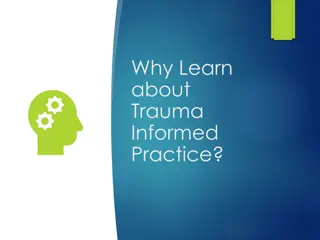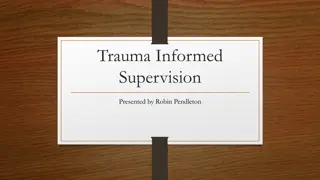Trauma and Recovery: Insights and Challenges
Explore the impact of trauma on individuals, families, and communities, uncover ways people cope with horror, and address disparities and historical trauma. Learn about the prevalence of childhood abuse in substance abuse treatment and the high rates of trauma among those with psychiatric diagnoses, substance abuse histories, homelessness, and more.
Download Presentation

Please find below an Image/Link to download the presentation.
The content on the website is provided AS IS for your information and personal use only. It may not be sold, licensed, or shared on other websites without obtaining consent from the author.If you encounter any issues during the download, it is possible that the publisher has removed the file from their server.
You are allowed to download the files provided on this website for personal or commercial use, subject to the condition that they are used lawfully. All files are the property of their respective owners.
The content on the website is provided AS IS for your information and personal use only. It may not be sold, licensed, or shared on other websites without obtaining consent from the author.
E N D
Presentation Transcript
From Whats Wrong to Whats Happened Brad Hansen -bhansen@ftnys.org Daphnne Brow-Dbrown@ftnys.org Bill Gamble billmhep@aol.com Suzanne Hall-Westcott shall_westcott@verizon.net,
People Recovering from Addictions People involved in Mental Health Recovery Youth with Behavioral Challenges and Their Families
Expecting that people have experienced trauma Understanding the impact on individuals, families and communities Understanding the effects on people using services, people who provide services, and the organizations we work in Understanding the connection between trauma in the past and experiences in the present
Understanding ways people cope in the face of horror Re-thinking the services and supports we provide Taking social action to change the conditions Addressing disparities and historical trauma as well as interpersonal trauma
Up to two-thirds of both men and women in substance abuse treatment report childhood abuse or neglect. (SAMHSA CSAT, 2000) Teenagers with alcohol problems are 21 times more likely to have been sexually abused than those without such problems. (Clark et al., 1997) Seventy-one to ninety percent of adolescent and teenage girls and twenty-three to forty-two percent of adolescent and teenage boys in a Maine inpatient substance abuse treatment program reported histories of childhood sexual abuse. (Rohsenow et al., 1988) HMO adult members who had experienced multiple childhood exposures to abuse and violence had a 4- to 12-fold increased risk of alcoholism and drug abuse, and a 2- to 4- fold increase in smoking. (Felitti et al., 1998) 5
Studies show about 85% of people with psychiatric diagnosis are trauma survivors Similar rates among people with histories of substance abuse, foster care placement, homelessness, and incarceration Nearly 100% of incarcerated women are trauma survivors Both staff and people using services may be trauma survivors 1 Mueser et al, 2004; 2 Goodman et al, 1997; 3 Buhrich et al, 2006; 4 Moncrieff et al, 1996; 5 Greeson et al, 2011; 6 Wallace et al, 2011. 6
Extreme stress brought on by shocking or unexpected circumstances or events and enduring conditions that overwhelm a person s ability to cope. Results in feelings of helplessness, and extreme fear and horror. Threats are perceived as psychological and/or bodily violation, threat of death, or serious injury to self or a loved one. The event may be witnessed or experienced directly by both individuals and groups 8
War/terrorism/combat Childhood sexual, physical, emotional abuse, neglect, and abandonment Community and school violence, bullying/hate crimes Cultural dislocation or sudden loss, displacement Rape, sexual assault, trafficking Historical/generational targeted violence Domestic violence Other violent crime Chronic stressors like racism, poverty Catastrophic injury or illness, death, loss, grief Natural disasters Invasive medical procedures Institutional abuse and neglect Any misuse of power by one person or group over another Abuse using religion Cave, Johnan, 2001 9
We are wired for survival We may be aware or unaware. Responses may be visible or invisible. Information from internal and sensory sources Freeze Flight Fight Cave. Curley 2015
For many of us who have experienced abuse and violence, our bodies and brains are on constant alert for danger Reassurance that we are safe may not help turn off the alarm Teaching people in distress about trauma can help Trustworthiness is essential 11
At the core of traumatic stress is a breakdown in the ability to regulate internal states. This concept of self-regulation is critical for understanding trauma and its impact. Bessel van der Kolk 20
Arousal Hyperarousal Numbing Attention Dissociation Hyper-focus Emotion Absent Overwhelming 1 3 N. Miller
Survivors may be responding to the present through the lenses of their past Things survivors do to cope may be misinterpreted by staff as non-compliance Can lead to punitive responses by staff to people who are struggling with trauma responses Sometimes people are unaware that their challenges are related to trauma 14
Leave people feeling powerless Have lasting effects on the ability to trust others and form intimate relationships Impact relationships with self, others, communities, and environment Create distance between people Be particularly damaging, especially when inflicted by loved ones or trusted caregivers 16
Trauma survivors often have sensitive radar for detecting dishonesty and good reasons to be sensitive to misuse of power and authority. How will this impact services? Penney and Cave 2010 17
If, how, and when a person chooses to talk about experiences is personal Some may not label what happened as trauma Be aware of the words you use and be prepared that other s words may be different 18
Trauma-informed approach relies on connection Connecting can be hard work Many providers and peers supporters have their own experiences with trauma Self-awareness and self-care are essential to avoid doing more harm; they protectsour empathy and supports effective connections 20
The Perspective of Staff The Perspective of Staff The Perspective of the Person in Treatment The Perspective of the Person in Treatment Helpful Resources -- https://store.samhsa.gov/shin/content/SMA06 -4055/SMA06-4055-A.pdf
Peer Self New medications Emphasis on recovery Understanding the relationship between trauma and mental illness Peer- -delivered services Self- -help techniques New medications Emphasis on recovery Understanding the relationship between trauma and mental illness delivered services help techniques
Unaware that toxic stress causes harm to a childs brain emotional abuse by other parent/ partner bullying community violence household substance abuse/ mental health challenges war & natural disasters Exposure to these childhood experiences increases the need for parents and caregiver to be educated on the effects of childhood stressors
Increases the risk of : Alcohol and substance abuse Social, emotional and behavioral health challenges Physical health challenges Unhealthy relationships .. and more
Teach parents to create: Safe environments physically and emotionally Help children to identify their feelings and emotions Healthy attachments and nurturing relationships Stable homes that meet a child s basic needs o food o shelter o access to health care o education food shelter access to health care education
Mental Health, Addiction and Family Networks
Every service or program can work towards becoming trauma-informed. This means examining our environments, relationships, and practices for anything that inhibits physical or emotional safety, power imbalances, and doing for or to rather than doing with. Trauma-specific interventions are designed specifically to address the consequences of trauma for an individual and to facilitate healing.
Are people currently safe? For example, all trauma is not post. With domestic violence there are current risks and potential for coercion and undermining of recovery. Providers may act with power over intentionally or unintentionally, it can hinder recovery by bringing about trauma reminders, retraumatizing someone or revictimizing someone Healing is not a linear process
Safety Collaboration Shared power Respect Transparency
Parallel Process Parallel Process Impact of stress and trauma on organizations Impact on staff who work there Impact on people accessing services 3 1 Bloom, S. SAGE for Organizations, Warshaw, 2009
A small group of people could change the world. Indeed, it s the only thing that ever has. Margaret Mead
